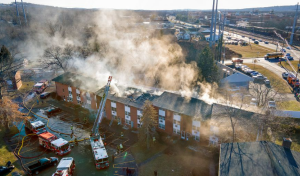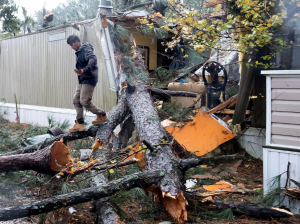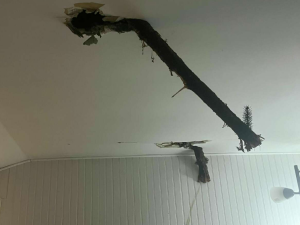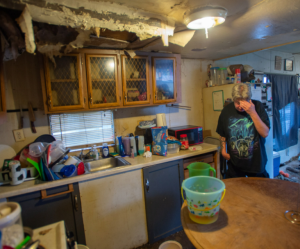
By Thomas Frank
A panel of experts has recommended that millions more Americans buy flood insurance at a moment when floods caused by climate change are increasing.
Flood insurance is a major weakness in the climate change protection system. Millions of Americans do not have it and could face ruinous financial consequences if they lose their homes.
A dramatic proposal could shrink the insurance gap in the country by requiring millions of homeowners to purchase flood insurance for the very first time. This would cost them potentially thousands of dollars per year.
According to the report provided by E&E News, a panel of federal advisors has recommended that the government expand areas considered to be high-risk for flooding by regulators.
It would have far-reaching consequences and be costly, as property owners are legally required to purchase flood insurance in these areas if they own a property that is protected by a mortgage backed by the federal government.
The flood insurance is separate from the homeowners’ policy, and only a fraction of U.S. homes have flooded policies.
The cost of ownership could be increased by expanding the requirement for flood insurance to include millions more properties. This would disrupt the housing market across the country. It could protect financially millions of people, who are currently without coverage due to the rising risk of flooding. After a large flood, homeowners who are uninsured can only receive a few thousands dollars of federal aid.
This adjustment would come as a shock, said Jeremy Porter of the First Street Foundation in New York, a nonprofit organization that evaluates climate risks.
The proposal does not specify how many more property owners will be required to purchase flood insurance. The cost of coverage is about $1,000 per year. However, prices are increasing rapidly due to climate change.
Experts believe that the number of properties in high-risk flood areas is too low.
According to the First Street Foundation, 19 million homes should be located in high-risk zones.
Porter stated that “Half all properties in the United States with a significant flood threat don’t even know about it, because they have not been mapped into” a federal risk zone.
This new proposal is intended to correct well-documented issues with federal flood maps, which have led to an underuse of flood insurance in America. These maps were criticized because they excluded large areas of flooding-prone land and led people living outside of designated high-risk zones to think that their homes are safe.
Chad Berginnis said that the proposal has a “significant positive impact” on people’s financial protection. Berginnis is executive director of Association of State Floodplain Managers. Insurance is a first-line defense.
A report from the Technical Mapping Advisory Council was released in 2012. The council, created by Congress in 2012 in order to improve the flood control program in response to challenges like climate change, recommends the expansion. The council’s members are state flood officials as well as experts from federal agencies like NOAA and Federal Emergency Management Agency.
The Council recommends FEMA make policy changes. FEMA produces U.S. Flood Maps and manages the largest flood insurance program in the country. At a Friday meeting, the council will discuss its recommendations.
The council recommended that FEMA extend its flood-prone areas. It also proposed expanding “flood protected areas”, where FEMA restricts construction due to flood hazards.
FEMA restrictions are in place for 22,000 counties or municipalities. These FEMA regulations aim to restrict development and safety standards such as the elevation of buildings.
Some lawmakers and the real estate sector may be opposed to this proposal. They want to prevent their constituents being forced to purchase flood insurance.
Michael Mittelholzer said, “I am concerned that new housing projects will not be possible under this proposal.” This could pose a challenge for localities that want to build more homes.
Mittelholzer raised concerns about potential costs of increasing the requirement for flood insurance and if the increase “would be subject to congressional review.”
Rob Moore of Natural Resources Defense Council’s climate and water group praised the proposal to expand flood protection zones.
Moore stated that this recommendation was very important. The FEMA standards can be the only code of building or zoning that is applicable to a particular development.
The mapping council’s report suggests that FEMA has the power to redefine flood zones, but new definitions may be scrutinized by Congress.
FEMA has been criticized by some lawmakers for a change to its insurance rate structure that was unrelated and caused premiums in certain cases to rise thousands of dollars. This rate restructuring is intended to better reflect the flood risk in insurance rates. It will result in price increases for 80 per cent of the nearly 4.7 million policyholders who have policies through FEMA’s National Flood Insurance Program.
The restructuring, though hailed as a positive by environmentalists and other groups, has been condemned as a negative by legislators from states along the coast, such as Louisiana, New Jersey and Florida, whose residents could see their insurance rates rise by as much as $8,000. Ten attorneys general, all Republicans, are suing FEMA in an attempt to stop its new rate structure.
FEMA stated in a Thursday statement about the report of the Mapping Council, that “as floods become more severe and frequent, FEMA works with its agency partners continuously to develop an overall picture of the hazards and risks throughout the country.”
In recent years, flood damage has increased as climate changes have intensified rains. Also, development in areas prone to flooding has been increasing. Since 2022, major flood damages have occurred in previously safe states like Kentucky and Vermont.
In response to an agency request from April, the mapping council examined FEMA flood zones and analyzed whether or not the areas at risk of flooding should be increased. The council, in response to FEMA’s efforts to raise the number of homes with flood insurance and increase flood awareness among the public, has suggested policies that would make the people aware of the flood risks. For example they have recommended requiring sellers of property to reveal flood histories.
In 2024, the mapping council will present to FEMA its final flood zone report.
It is important to restore your property after a water incident. Water damage cleanup offer comprehensive services, such as water removal, drying, mold remediation and structural repairs. If you like or are interested in what we offer the solutions to your problem and in a professional way we will help you if you want to investigate further, go here Imperial Restoration water and flood damage restoration Toronto Expert restoration services will ensure that the damage to your home is minimised and it is quickly restored back to its safe, habitable state. To protect your home and maintain a safe and healthy living environment, you need to act quickly and seek professional help.





